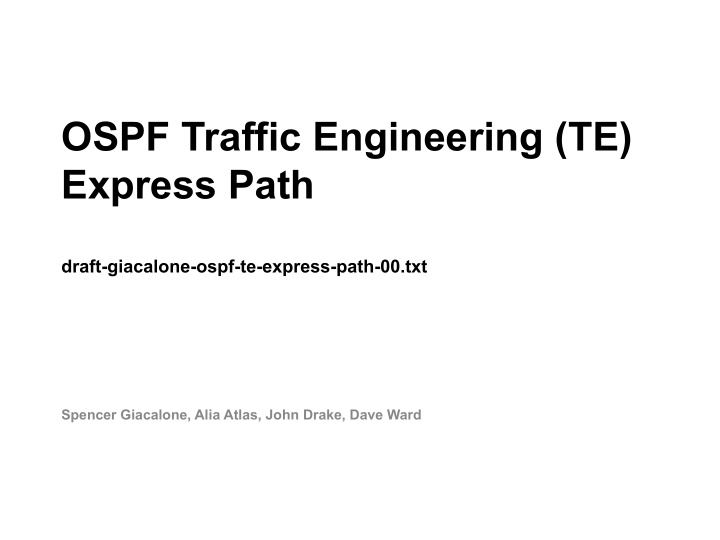



OSPF Traffic Engineering (TE) Express Path draft-giacalone-ospf-te-express-path-00.txt ¡ ¡ Spencer Giacalone, Alia Atlas, John Drake, Dave Ward
Agenda • Introduction to OSPF TE Express Path – Background – Problem – Protocol overview – Encodings – Next steps – Questions draft-giacalone-ospf-te- IETF 80 express-path-00.txt
The Scenario • Financial networks have changed: – Orientation towards machine (“algo”) trading • Arbitrage • Real time data: Low latency (LL) and ultra low latency (ULL) – Milliseconds and (increasingly) microseconds count • High rate flows • Not able to gap (drop) packets • Out of SLA is out of service! draft-giacalone-ospf-te- IETF 80 express-path-00.txt
Problem • We need to guarantee delivery of large quantities of data with the lowest latency- not lowest cost, etc – In certain richly interconnected networks, interface cost is becoming generally irrelevant. Performance Is King. This is a real and current need. • We have high redundancy and bandwidth, but managing performance flows is difficult : – Overall path lengths vary – We act as a service provider, but are not one in the classical sense • Dependant on underlying transport services • Segments not always dark fiber • Full transport service “stack” not visible draft-giacalone-ospf-te- IETF 80 express-path-00.txt
Static Costing Is A Problem • Difficult to capture latency, loss, and bandwidth in single static metric • Performance changes- latency, loss, etc – Path protection – Flaps, drops, etc – I need to know the current values at LSP compute time • Complicated, error prone, time consuming draft-giacalone-ospf-te- IETF 80 express-path-00.txt
Overview • OSPF TE Express Path simplifies these issues • Automatically distributes performance data – Allows control plane manipulation • To permit MPLS tunnel setup, failover, fail back • Based on network performance – Intentionally independent from measurement protocols • E.g. MPLS TP, PTP, etc – Also, intentionally independent from “applications” • Routing/MPLS enhancements • Weighted ECMP • Others • Modular and extensible draft-giacalone-ospf-te- IETF 80 express-path-00.txt
What About Stability?? • Aimed at MPLS TE • Averaged values • Controlled announcement • Does not define how control plane reacts- just distributes data • Not having a déjà vu draft-giacalone-ospf-te- IETF 80 express-path-00.txt
Protocol Architecture • Extends RFC 3630 • Two Main Types of Sub-TLV – Nominal (Routine) Sub-TLVs • Steady state path selection according to performance • Initial tunnel build • Fail over path selection and monitoring (Non SLA compliant best path may not be desirable for fail over use) • Possibly also general monitoring – Alternative method- topology database » Link by link or path – Anomalous (S ignificant) Sub-TLVs • Can trigger re-computation when performance SLAs are violated • Fail back • Different announcement scheduling and averaging periods • Individually configured • Intentionally kept separate to simplify implementations draft-giacalone-ospf-te- IETF 80 express-path-00.txt
Sub-TLVs • Five New Sub-TLVs (Currently) 1. Nominal Unidirectional Link Delay 2. Nominal Unidirectional Delay Variation 3. Nominal Unidirectional Link Loss 4. Anomalous Unidirectional Link Delay 5. Anomalous Unidirectional Link Loss • Next version will include additional sub-TLVs for items like residual bandwidth draft-giacalone-ospf-te- IETF 80 express-path-00.txt
Encoding – Latency or jitter as rolling average, to remote peer, floating point – Loss as packet percentage – Sent when threshold exceeded • Different thresholds for different sub-TLVs • Configurable • And when reuse threshold passed (Anomalous sub-TLVs only at this time) • Configurable • And when reuse threshold passed (Anomalous sub-TLVs only at this time) draft-giacalone-ospf-te- IETF 80 express-path-00.txt
Simple MPLS TE Example CSPF- Initial state for path selection • Upon SLA violation, Anomalous sub-TLV prompts CSPF – And fail over to secondary • CSPF uses Nominal sub-TLVs ensure secondary path is conformant conformant draft-giacalone-ospf-te- IETF 80 express-path-00.txt
Next Steps- Short/Mid Term • Propose • Propose OSPF WG adoption – Will also be presented in RTGWG for cross pollination – New Sub-TLVs aimed at weighted ECMP • Revise draft • Residual bandwidth • Available bandwidth – Modifications based on feedback • Modeling • Interworking/requirements with MPLS TP draft-giacalone-ospf-te- IETF 80 express-path-00.txt
Next Steps- Longer Term Longer term plans include IS-IS TE Express Path, and drafts related to “applications” such as MPLS TE control plan Express Path, Weighted ECMP, and possibly others draft-giacalone-ospf-te- IETF 80 express-path-00.txt
Questions draft-giacalone-ospf-te- IETF 80 express-path-00.txt
Recommend
More recommend